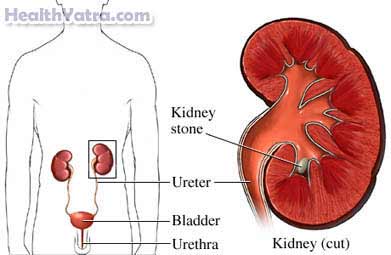Definition
Kidney stones are pieces of a stone or crystal-like material. These stones form inside the kidneys or other parts of the urinary tract. The kidneys remove waste from the body. They also balance the water and electrolyte content in the blood by filtering salt and water.
There are several types of kidney stones:
- Calcium oxalate
- Calcium phosphate
- Struvite
- Uric acid
- Cystine

Causes
The cause of your kidney stone may be depend on the type of stone that you have. Calcium stones are the most common type.
- Calcium oxalate or phosphorus stones—These kidney stones form when the concentration of calcium or other minerals in the urine becomes too high.
- Struvite stones—These stones develop as a result of a urinary tract infection. The stones are composed of ammonium, magnesium, and phosphate salts.
- Uric acid stones—These stones form when urine is acidic. This may also occur in people with gout or having chemotherapy.
- Cystine stones—Due to a rare genetic disorder that causes the kidneys to accumulate excess amounts of cystine, one of the amino acids that make up proteins.
Risk Factors
Common factors that increase your risk of kidney stones include:
- White adult male under 50 years old
- Personal history of kidney stones
- Family history of kidney stones
Other factors that increase your risk of kidney stones include:
Calcium oxalate or phosphorus stones:
- Excess dietary sodium and oxalate. Oxalate can be found in green, leafy vegetables, chocolate, nuts, or tea.
- Low fluid intake, especially during warmer weather, which can lead to dehydration
- Overactive parathyroid gland
- Chronic bowel disorders such as Crohn’s disease or ulcerative colitis
- Some diuretics
- Calcium-based antacids
Struvite stones:
- History of urinary infection
- More common in women
Uric acid stones:
- Excess dietary red meat or poultry
- Gout
A rare genetic disorder increases risk of cystine stones.
Symptoms
In many people, kidney stones do not cause symptoms and pass during urination. Other people may have symptoms, including:
- Sharp, stabbing pain in the mid-back that may occur every few minutes and last from 20 minutes to one hour
- Pain in the lower abdomen, groin, or genital areas
- Nausea and vomiting
- Blood in the urine
- Frequent urge to urinate
- Burning pain during urination
- Fever
Diagnosis
The doctor will ask about your symptoms and medical history, and perform a physical exam. Your doctor may recommend further testing to confirm a diagnosis and rule out other conditions. These may include:
- Tests to gather information about your urine:
- Urinalysis
- 24-hour urine
- Urine culture
- Blood tests
- Tests to take detailed pictures of your kidneys and urinary system:
- X-ray
- Spiral CT scan
- Ultrasound
- Intravenous pyelogram (IVP)
Treatment
Treatment depends on the size and location of the kidney stone. Treatment may include one or more of the following:
Water
For small kidney stones, drinking at least two or three quarts of water a day helps the body pass the stones during urination. The doctor may provide a special cup to catch the stone when it passes so it can be analyzed. If you are having a hard time keeping fluids down, you may need to be hospitalized to receive IV fluids.
Medications
Your doctor may recommend that you take pain medication. You may also be prescribed medications that may help you pass your kidney stones during urination.
Surgery
Surgery may be needed if the stones are:
- Very large or growing larger
- Causing bleeding or damage to the kidney
- Causing infection
- Blocking the flow of urine
- Unable to pass on its own
Ureteroscopy
Ureteroscopy uses a small camera to locate the stones located in the ureter or kidney. Once found, a small basket is used to capture and remove the stones. Larger stones can be broken up into small pieces with a laser.
Percutaneous nephrolithotomy (PNL)
PNL is used to treat large stones located in the kidney. A small incision is made in the lower back. A nephroscope is passed through a tube so the kidney stones can be seen. The stones are broken in to smaller pieces and removed. A temporary drain may left in the incision site.
Lithotomy
Lithotomy is an open surgery used to remove stones. This is rarely used because of the less invasive options available.
Extracorporeal Shock Wave Lithotripsy (ESWL)
ESWL uses a device called a lithotripter that is applied to the skin. The lithotripter sends shock waves into the body. The impact of the shock waves breaks up the larger stones so they can be passed during urination.
If you are diagnosed as having kidney stones, follow your doctor’s instructions.
Prevention
Once you have formed a kidney stone, you are more likely to form another. Here are some steps to prevent this condition:
- Drink plenty of fluids, especially water.
- Talk to your doctor about what diet is right for you. Depending on the type of stone you have, you have to avoid certain food or drinks.
- Depending on what type of stone you have, certain medicines may be prescribed to keep stones from forming again.
